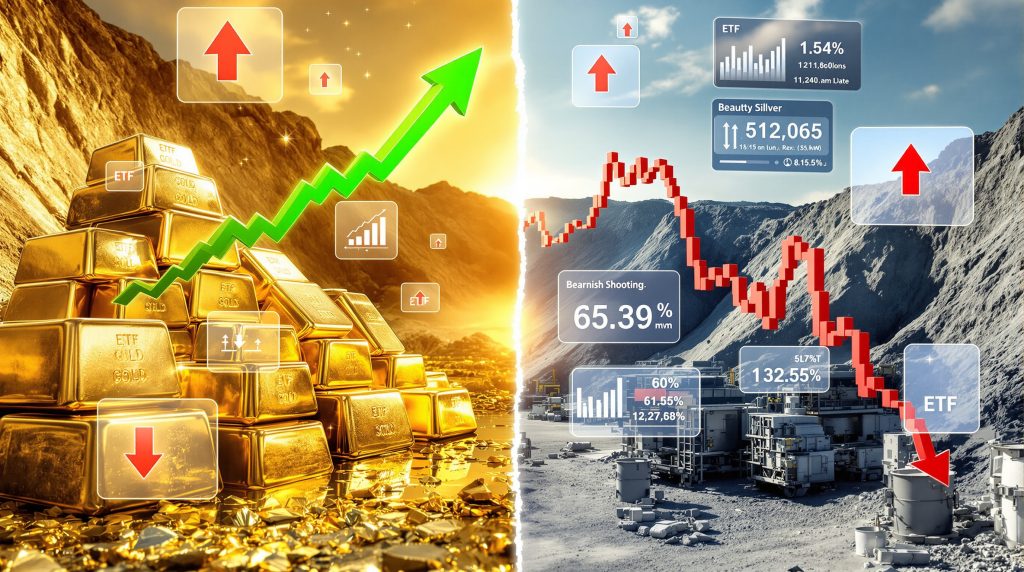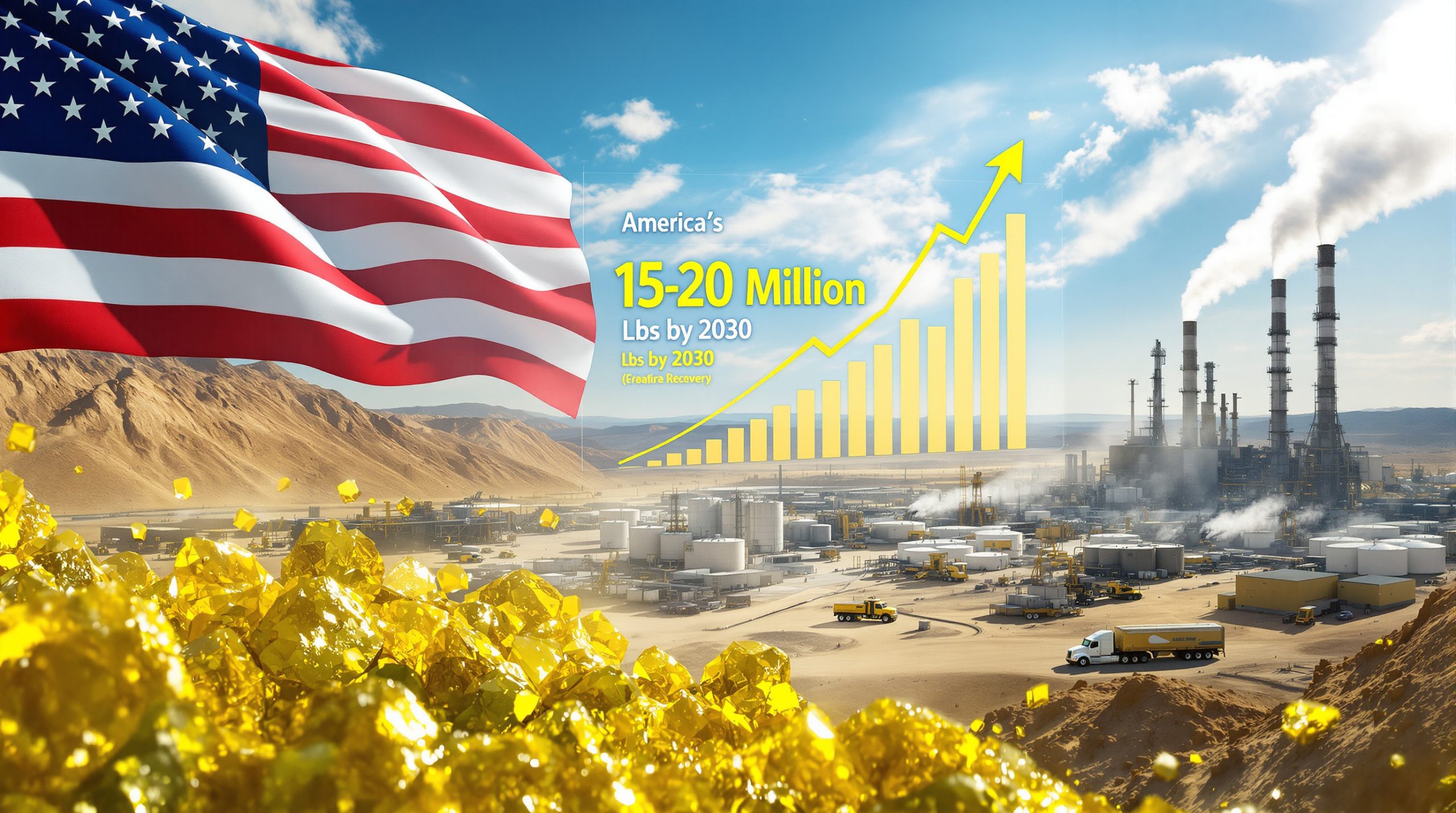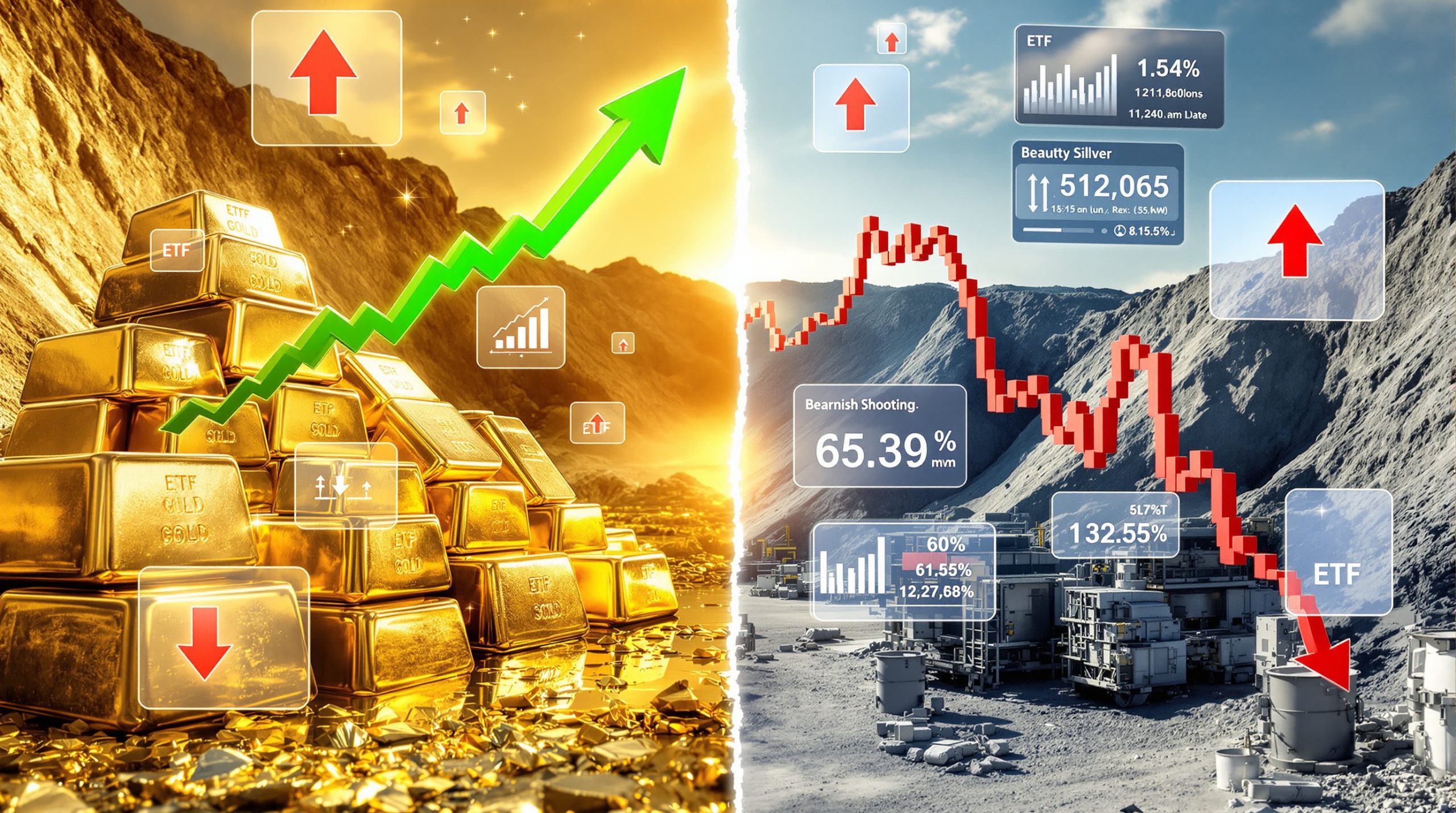The relationship between precious metals prices and mining company valuations represents one of the most perplexing patterns in modern finance. While gold surged to unprecedented heights of $2,740 per ounce in late 2024 and silver reached multi-year peaks above $34, mining equities have consistently failed to capture proportional gains, creating a systematic underperformance that challenges traditional investment logic. Furthermore, this disconnect has become increasingly pronounced as gold highs analysis reveals deeper structural issues within the sector.
Defining Underperformance in Mining Equities
Mining sector underperformance manifests when equity valuations lag behind their underlying commodity price movements. According to World Gold Council analysis, gold mining equities have historically captured only 30-40% of gold price gains during bull markets while experiencing 1.5-2x the downside during corrections. This asymmetric relationship creates persistent headwinds for investors seeking leveraged exposure to precious metals appreciation.
The phenomenon becomes particularly pronounced during commodity rallies, where operational leverage should theoretically amplify profit margins. Instead, miners underperforming metals has become the norm, with mining companies struggling to translate higher commodity prices into sustainable shareholder returns. Moreover, understanding gold-silver ratio insights provides crucial context for evaluating relative sector performance.
Historical Context of Sector Divergence
The Philadelphia Gold and Silver Index declined approximately 10% from 2011 to 2015, while gold prices fell roughly 45% during the same period. This pattern demonstrates how mining companies can amplify downside movements while failing to capture proportional upside, creating a structural disadvantage that extends beyond typical market cycles.
Recent market action in October 2025 reinforced this trend, with gold mining ETFs GDX and GDXJ experiencing severe gap-down selloffs despite gold maintaining relative strength above $4,000 per ounce. Silver miners performed even worse, with SIL and SILJ posting significant declines while silver held above $50 per ounce.
Why Do Mining Stocks Consistently Lag Commodity Prices?
The systematic underperformance of mining equities stems from multiple structural challenges that compound over time, creating sustained pressure on valuations despite favourable commodity environments. Additionally, evolving mining innovation trends highlight the need for technological transformation to address these persistent challenges.
Operational Cost Inflation Pressures
Mining operations face relentless cost pressures that often outpace commodity price gains. According to PwC's "Mine 2024" report, energy costs represent 20-30% of total mining operating expenses, with the International Energy Agency reporting that mining sector energy costs increased by an average of 35% between 2020 and 2023.
Primary cost drivers include:
• Diesel fuel price volatility affecting extraction and transportation operations
• Specialised mining equipment costs with limited supplier competition
• Skilled labour shortages driving wage inflation of 15-20% across major mining jurisdictions from 2021-2024
• Environmental compliance and regulatory costs that compound annually
The World Gold Council reported that global average All-In Sustaining Costs (AISC) for gold mining increased from approximately $1,050 per ounce in 2020 to $1,350 per ounce in 2023, representing a 28.5% increase that outpaced inflation in many jurisdictions.
Capital Allocation Missteps and Value Destruction
Mining companies have historically struggled with capital discipline during commodity cycles. McKinsey & Company analysis revealed that mining companies destroyed approximately $500 billion in shareholder value through poor merger and acquisition decisions made during the 2003-2012 commodity supercycle, with acquisitions completed at peak prices generating returns well below the cost of capital.
This pattern of value destruction during favourable commodity environments has created lasting scepticism among institutional investors, contributing to persistent valuation discounts even when operational fundamentals appear strong. Consequently, the ongoing consolidation and M&A dynamics reflect industry efforts to address these historical missteps.
Regulatory and Environmental Compliance Costs
Evolving environmental standards impose additional operational expenses that directly impact profitability without corresponding commodity price adjustments. These ESG compliance initiatives, while necessary for long-term sustainability, create immediate cost pressures that erode the theoretical benefits of higher commodity prices.
What Technical Indicators Signal Mining Sector Weakness?
Technical analysis reveals specific patterns that consistently precede mining sector corrections, providing valuable insights for investors monitoring sector health and timing entry points.
Bearish Candlestick Formations in Mining ETFs
Weekly chart analysis during October 2025 revealed multiple warning signals through distinctive candlestick patterns across major mining ETFs. Silver miners exhibited particularly concerning formations over three consecutive weeks.
Bearish hanging man patterns appeared two weeks prior in SIL and SILJ, characterised by bodies positioned near the bottom of the candle range with long upper tails. These formations indicate selling pressure at elevated levels despite apparent strength.
Bearish shooting stars developed the following week, featuring bodies positioned higher in the candle range with extended upper wicks. These patterns signal market exhaustion after extended uptrends.
The October 17, 2025 session produced strong bearish shooting stars with bearish engulfing characteristics, confirming the technical deterioration that began weeks earlier. Similar patterns emerged in gold miners GDX and GDXJ, despite gold finishing up over 5% for the week.
Options Flow Analysis as Predictive Tool
Call-to-put volume ratios in precious metals ETFs have historically provided early warning signals for sector corrections. Analysis of GLD and SLV options activity revealed extreme spikes in call volume minus put volume during the week ending October 17, 2025.
Historical spike comparisons:
| Time Period | Market Outcome | Duration of Correction |
|---|---|---|
| 2011 Peak | Major secular correction | 4+ years of underperformance |
| 2020 COVID Recovery | Intermediate correction | 4-6 months of consolidation |
| April 2025 | Brief consolidation | 4.5 months sideways action |
| October 2025 | Pending resolution | Anticipated intermediate-term peak |
These extreme call volume spikes have coincided with intermediate-term peaks, as excessive bullish sentiment typically marks cyclical turning points in precious metals markets.
How Do Gold and Silver Miners Compare in Performance?
The performance divergence between gold and silver mining companies reveals important insights about sector dynamics and relative volatility characteristics during different market conditions. Moreover, understanding bull vs bear market perspectives helps investors navigate these complex dynamics.
Silver Miners' Amplified Volatility
Silver mining equities exhibit significantly greater volatility than gold miners due to silver's dual role as both precious metal and industrial commodity. According to The Silver Institute, industrial applications account for approximately 50% of total silver demand, with photovoltaics representing the fastest-growing segment at roughly 14% of total demand in 2023.
Silver miner characteristics:
• Higher operational leverage to commodity price movements
• Greater sensitivity to industrial demand fluctuations
• More pronounced corrections during market stress periods
• Smaller market capitalisation increasing overall volatility
During the October 17, 2025 selloff, silver miners demonstrated this amplified volatility, with SIL and SILJ experiencing more severe declines than their gold mining counterparts, despite silver maintaining strength above $50 per ounce.
Gold Miners' Relative Stability
Gold mining companies benefit from more stable demand profiles, with jewellery and investment accounting for approximately 85-90% of total gold demand according to World Gold Council data. Industrial applications represent less than 10% of total demand, creating more predictable operational environments.
According to World Gold Council analysis, the total market capitalisation of gold mining companies globally reached approximately $350 billion as of mid-2024, while silver miners represented roughly $40-50 billion, making silver miners approximately 12-15% the size of the gold mining sector.
Which Support Levels Matter Most for Mining Recovery?
Understanding critical support levels helps investors identify potential entry points and assess downside risk during mining sector corrections.
Technical Support Analysis for Gold Miners
Key support zones for gold prices, which directly impact mining company valuations, centre around major breakout levels and moving average convergences:
Primary support levels identified for late 2025:
• $3,600-$3,700 zone: Previous breakout level around $3,400 with minimal selling since vertical move began
• $4,000 level: Initial support area for potential bounce attempts
• $3,500 floor: Professional floor estimate from market analysts
• 200-day moving average: Projected convergence at $3,600 by year-end 2025
A 15% decline from gold's peak of $4,400 would target the $3,700 level, aligning with technical support analysis. The 200-day moving average trending higher creates potential buying opportunities at convergence points.
Silver Mining Support Structures
Silver miners often find support at gap levels created during major breakout moves. Current analysis identifies several critical zones:
Silver support methodology:
-
Gap support at $40: Strong support below the gap at $39
-
Above-gap support: $40.50-$41 range provides secondary support
-
Short-term levels: $42 and $48 representing pullback targets
-
200-day convergence: Moving average projected to trend higher through year-end
These gap levels frequently serve as magnetic support zones during corrections, with volume characteristics and bounce quality providing confirmation of support validity.
What Does the Gold-Silver Ratio Reveal About Sector Health?
The gold-silver ratio serves as a crucial indicator for assessing the relative health of precious metals markets and their associated mining companies.
Historical Ratio Patterns and Market Cycles
The ratio closed at 81-83 on October 17, 2025, after an intraday spike to 85, demonstrating continued gold strength relative to silver. Historical analysis reveals that secular bull markets in precious metals typically conclude when the gold-silver ratio approaches 15:1, indicating silver's outperformance during final bull market phases.
Historical context provides perspective:
• March 2020 peak: Ratio reached approximately 125:1 during COVID-19 panic
• 1990s average: Ratio maintained approximately 47:1
• 1970s commodity bull: Ratio reached lows near 30:1
Current ratios significantly above the 15:1 historical bull market endpoint suggest substantial room for continued precious metals appreciation, with silver potentially outperforming gold during later stages.
Mining Sector Implications of Ratio Movements
Changes in the gold-silver ratio directly impact mining company valuations and investment strategies:
Rising ratios favour gold miners over silver producers, as gold's relative strength supports higher margins for gold-focused operations.
Declining ratios benefit silver miners and dual-metal producers, as silver's outperformance creates enhanced operational leverage.
Extreme ratios often signal sector inflection points, providing timing indicators for rotation between gold and silver mining investments.
Are There Opportunities in Mining Sector Corrections?
Mining sector corrections, while challenging for existing shareholders, create potential opportunities for investors with appropriate risk tolerance and strategic patience.
Identifying Quality Companies During Downturns
Corrections separate well-managed mining companies from weaker operators, creating opportunities to acquire quality assets at discounted valuations. According to S&P Global Market Intelligence, the average net debt-to-EBITDA ratio for the top 50 gold miners improved from 1.2x in 2020 to 0.4x by Q2 2024, indicating significantly stronger balance sheets across the sector.
Quality indicators for mining companies:
• Strong balance sheets with manageable debt levels and improved debt-to-EBITDA ratios
• Proven management teams with disciplined capital allocation track records
• Low-cost operations with sustainable competitive advantages
• Diversified asset portfolios reducing single-mine operational risk
The World Gold Council reported that the lowest-cost quartile of gold producers maintained AISC below $1,000 per ounce in 2023, providing significant margins at gold prices above $3,500.
Timing Considerations for Sector Entry
Recent market analysis suggests that current corrections may provide enhanced entry opportunities for patient investors. BMO Capital Markets reported that the median EV/EBITDA multiple for gold miners contracted from approximately 8x in early 2024 to 6.5x by mid-2024, despite higher gold prices.
Optimal entry conditions typically emerge when:
-
Technical indicators suggest oversold conditions across major mining ETFs
-
Commodity prices maintain strength despite mining stock weakness
-
Institutional selling pressure begins to subside based on options flow analysis
-
Quality companies trade at significant discounts to intrinsic value calculations
Current market conditions suggest these criteria may align over the coming weeks and months, potentially rewarding investors with available capital who waited on the sidelines.
What Structural Changes Could Improve Mining Performance?
The mining sector's persistent underperformance has prompted industry-wide initiatives aimed at improving operational efficiency and shareholder returns through technological innovation and governance improvements.
Technology Integration and Automation
Advanced technologies offer potential solutions to traditional mining challenges that have historically contributed to cost inflation and operational inefficiencies:
Automation technologies and their impact:
• Autonomous haul trucks: Reducing labour costs by 30-40% while improving safety profiles
• Remote operation centres: Allowing centralised monitoring of multiple sites, as demonstrated by BHP's Perth facility
• Predictive maintenance systems: Using AI to reduce unplanned downtime by 20-30%
• Advanced exploration techniques: AI-driven systems improving resource discovery success rates
According to GlobalData, the global mining automation market is projected to grow from $3.5 billion in 2023 to $5.8 billion by 2028, representing a compound annual growth rate of 10.6%. Rio Tinto reported that its automated haul trucks in the Pilbara region achieved 15% higher productivity while reducing fuel consumption by 13%.
ESG Integration as Competitive Advantage
Environmental, social, and governance improvements, while initially costly, provide long-term competitive advantages that may address some structural challenges facing the sector. Furthermore, the Natural Resources Defense Council has documented how sustainable mining practices can reduce operational risks while improving community relations.
ESG benefits for mining operations:
• Sustainable operations: Attracting ESG-focused institutional capital with lower cost of capital
• Community partnerships: Reducing regulatory risks and operational disruptions
• Environmental compliance: Preventing costly remediation expenses and operational shutdowns
• Transparent governance: Rebuilding investor confidence through improved capital allocation
Research from the Rocky Mountain Institute indicates that mining companies with strong ESG ratings commanded valuation premiums of 10-15% compared to peers with weaker ESG performance as of 2023. S&P Global Market Intelligence reported that the top 50 mining companies increased technology and innovation spending to an average of 1.2% of revenue in 2023, up from 0.7% in 2019.
Navigating Mining Sector Complexity and Future Outlook
The persistent pattern of miners underperforming metals reflects deep-rooted structural challenges that extend beyond typical market cycles. While theoretical operational leverage should benefit mining companies during commodity bull markets, practical realities including cost inflation, regulatory pressures, and historical capital allocation missteps have consistently undermined these advantages.
Current market conditions in late 2025 suggest an intermediate-term correction may be underway, supported by extreme options positioning and bearish technical formations across major mining ETFs. However, with the gold-silver ratio maintaining levels of 81-83, significantly above the historical bull market endpoint of 15:1, the secular bull market in precious metals appears far from complete.
Key considerations for investors:
The nine consecutive weeks of gains preceding the October 17, 2025 correction created technically overbought conditions that demanded resolution. Call-put volume ratios reached extreme levels reminiscent of previous intermediate-term peaks, suggesting a healthy correction rather than a major secular reversal.
For investors seeking mining sector exposure, the upcoming correction may provide enhanced entry opportunities, particularly in quality companies with strong balance sheets and low-cost operations. The sector's cyclical nature and current technical setup suggest patience may be rewarded, though timing remains uncertain.
Technology integration and ESG improvements offer potential long-term solutions to structural challenges, but implementation timelines extend beyond immediate investment horizons. Investors must balance the sector's documented underperformance against potential rewards from successful navigation of these complex dynamics. Additionally, understanding miners underperforming metals as a structural phenomenon helps set realistic expectations for sector returns.
"Investment Disclaimer: This analysis is for educational purposes and does not constitute investment advice. Mining sector investments carry significant risks, and past performance does not guarantee future results. Investors should conduct thorough due diligence and consider professional guidance before making investment decisions."
Ready to Capitalise on Mining Sector Volatility?
Discovery Alert's proprietary Discovery IQ model delivers real-time notifications on significant ASX mineral discoveries, transforming complex market dynamics into actionable investment opportunities during sector corrections and recoveries. Begin your 30-day free trial today and discover why savvy investors rely on Discovery Alert's proven track record to identify the next breakthrough discovery before the broader market catches on.




